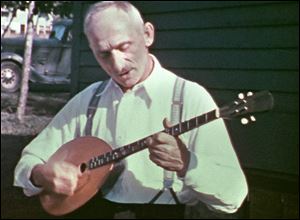
Michigan folk music trove released 75 years after trip
125 performers reflect mix of cultures, 10 languages
9/23/2013
A member of the Floriani family performs in Michigan’s Upper Peninsula. Michigan was fertile ground for folk music, brought to the region by a wave of immigrants in the early 20th century.
DETROIT — Detroit is famous for its music, from the Motown hits of the 1960s to the punk of Iggy Pop to the rap of Eminem.
Little known, though, is that Michigan was fertile ground for folk music, brought to the region by immigrants in the early 20th century and played in the logging camps, mines, and factory towns.
Folklorist Alan Lomax discovered the music in 1938 when he visited the Midwest on his famous 10-year cross-country trek to document American folk music for the Library of Congress.
A trove of his Michigan recordings is being released for the first time, coinciding with the 75th anniversary of Mr. Lomax’s trip.
“It was a fantastic field trip — hardly anything has been published from it,” said Todd Harvey, the Lomax collection’s curator at the library in Washington. The Michigan batch contains about 900 tracks and represents a dozen ethnicities.
Mr. Lomax, son of famous musicologist John A. Lomax, spent three months in Michigan on his research, which also took him through Appalachia and the deep South. He drove through rural communities and recorded the work songs and folk tunes he heard on a large suitcase-sized disc recorder powered by his car’s battery.
The trip was supposed to cover much of the Upper Midwest, but he found so much in Michigan that he made only a few recordings elsewhere in the region.
The collection includes acoustic blues from southern transplants, including Sampson Pittman and one-time Robert Johnson collaborator Calvin Frazier; a lumberjack ballad called “Michigan-I-O” sung solo by an old logger named Lester Wells; and a similar lament about life deep in the copper mines of the Upper Peninsula called “31st Level Blues,” performed by the Floriani family, who were of Croatian descent.
The 250 disc recordings of about 125 performers, along with eight reels of film footage and photographs, reflect the rich mixture of cultures in Depression-era Michigan, where immigrants fleeing poverty and persecution in Europe and the South came seeking jobs.
Natives of French-speaking Canada, Finland, Italy, Croatia, Germany, Poland, Ireland, and Hungary perform the songs, which represent 10 languages.
John and Alan Lomax’s archives at the library’s American Folklife Center encompass 10,000 sound recordings and 6,000 graphic images, documenting creative expression by cultural groups around the world.
Most famous were the field recordings made in the South, including those of Leadbelly, Muddy Waters, and Son House.
“Now you have the stories and the sounds of sailors, miners, and lumberjacks, ethnic communities who came to work ... and brought their traditions with them,” says Laurie Sommers, Michigan’s coordinator for the Lomax project.
One example is Exilia Bellaire, a woman from the Upper Peninsula community of Baraga who recorded “I Went to Marquette.” It’s sung in a mixture of French and English, and Mr. Harvey said the song is one of many that “captures [what] occurs when cultures interact with one another.”
Mr. Lomax’s Michigan research proved challenging.
Thieves twice broke into his car and stole equipment and films, and performers would hound him for money or liquor in exchange for recording them. He frequently requested more money from headquarters, in part, he wrote, because “songs in [Michigan] absolutely require beer.”